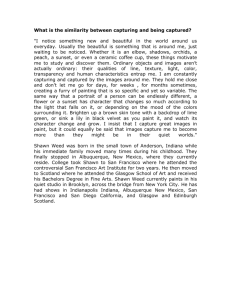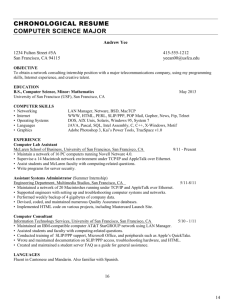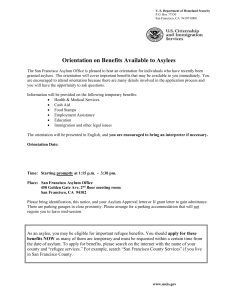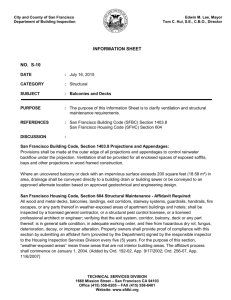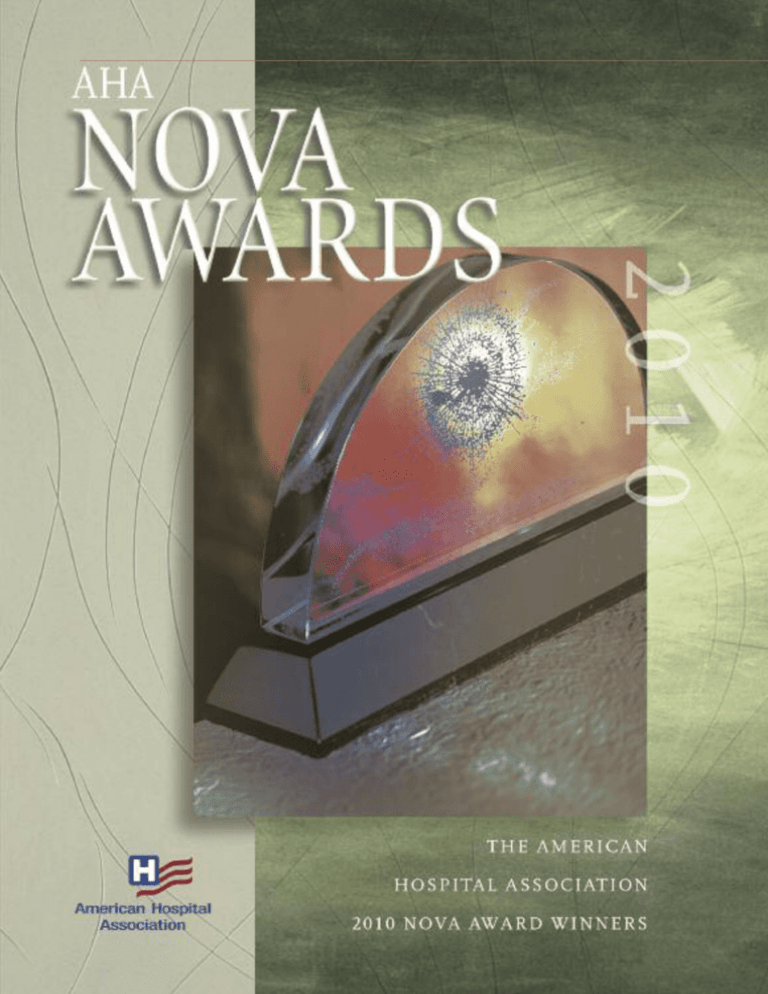
The 2010 AHA NOVA Awards
The five winners of the 2010 AHA NOVA Awards, sponsored by the
American Hospital Association and Hospitals & Health Networks,
excel in making a difference in the lives of the most vulnerable in their
communities. On the East Coast, that means developing alternatives
to emergency care for behavioral health and primary care. On the
West Coast, it means connecting every uninsured community resident with a primary care home and network of care. In between,
health systems ensure expectant mothers and children under age 2
have a healthy beginning, no matter their income; use telemedicine
to deliver high-touch care to children in schools, child care and family
service agencies; and offer a pediatric asthma program to reduce the
impact of the devastating disease on inner-city children. While the
programs are different, one key element is the same: All employ
extensive collaboration with like-minded community partners, in the
spirit of the AHA NOVA Awards.
CHICAGO WESTSIDE CHILDREN’S ASTHMA PARTNERSHIP
I
SINAI HEALTH SYSTEM, CHICAGO
Targeting Child Asthma Sufferers
T
TAKE A DEEP BREATH: Geoni McNeal, a 14-year-old asthma sufferer, uses an aero-chamber device, which administers a metered dose
inhaler. The Chicago Westside Children’s Asthma Partnership trains
and sends into the field community health workers and lay health educators to provide individualized care and education to kids and their
families.
THE GOAL I Reduce the frequency and impact
of asthma among children of African-American
families; to develop and train human capital
within affected communities; to select settings
and methods to make the most of child and
family participation.
THE PLAYERS I Among others, the Chicago
Asthma Consortium, Health and Disability
Advocates, Metropolitan Tenant’s Organization,
and the Sinai Urban Health Institute.
THE PLAN I Improve the asthma-related
knowledge of the child’s primary caregiver,
decrease the number of triggers to which the
child is exposed, improve medical management
of the child’s asthma; and improve the caregiver’s confidence in managing their child’s
asthma.
THE RESULTS I 200 percent drop in frequency of symptoms, 47.6 percent drop in ED visits,
50 percent drop in hospitalizations, 63.6 percent decline in nighttime asthma symptoms.
WINNER
Don Ontiveros
amika Johnson is 3 years old and suffers from asthma. She’s not
alone. One in four children in North Lawndale, a largely AfricanAmerican community on the west side of Chicago and one of the
poorest areas of the city, suffers from the disease. At 25 percent, that’s one of
the highest documented rates of asthma in the country.
Sinai Health System set out to change that. Sinai’s emergency department
historically has helped inner-city children from North Lawndale largely by
treating acute symptoms. But many children didn’t take the proper medications
and few followed up with a clinic or physician. Other factors, such as violence,
obesity and behavioral health issues, complicated the picture.
Sinai teamed with Chicago-area asthma organizations, disability advocates,
community interest legal organizations and the Sinai Urban Health Institute
to create Healthy Home, Healthy Child: Westside Children’s Asthma Partnership, the fourth iteration of the health system’s pediatric asthma intervention
program. The program trains and sends into the field community health
workers and lay health educators to provide individualized care and education
to Tamika (not her real name) and other North Lawndale kids and families.
“The people we serve live in all these amazingly vulnerable communities,”
says Steve Whitman, director of the Sinai Urban Health Institute. “We decided
we had to do something about it. We had to move outside the clinic to do additional good work.”
Drawing on the strength of partners such as the Chicago Asthma Consortium, Health and Disability Advocates and the Metropolitan Tenant’s Organization, Sinai visits children and their families in their homes to impart knowledge about asthma to the child’s primary caregiver, decrease the number of
triggers to which the child is exposed, improve the medical management of
the child’s asthma, and improve the caregiver’s confidence that they can properly
manage their child’s condition.
Sinai and its partners’ efforts have led to reductions in frequency of symptoms, reduced ED visits and hospitalizations, decreased exposure to asthma
triggers in the home and fewer nighttime home asthma emergencies. The
program also resulted in improved use of medications and expanded asthmarelated knowledge among families and caregivers. Cost savings from the program in recent years are on the order of $5 to $7 for each dollar spent, says
Whitman.
But Alan Channing, Sinai’s CEO, doesn’t measure success just in dollars.
After working with Sinai experts, Tamika and her parents have made some
dramatic changes. They moved from a damp basement apartment with moldinfested carpeting to an above-ground residence with hardwood floors. They
switched to more natural cleaning products to lessen Tamika’s problems, and
with a change in masks and tubing, home asthma treatments are now more
effective.
“We’ve tried to really understand our community’s needs and help create
these interventions that will make a difference,” Channing says. “We’ve taken
on the challenge of trying to speak for those folks who can’t speak for themselves.” •
HEALTH-E-ACCESS TELEMEDICINE PROGRAM
I
UNIVERSITY OF ROCHESTER MEDICAL CENTER, ROCHESTER, N.Y.
WINNER
Brad Dillsworth
Easy Access Telemedicine Visits
t was a common scenario in Rochester. A parent is called at work to pick
up his sick child from day care and told the child can’t return without
a letter from the doctor. Because the family doctor isn’t available, the
child winds up in the emergency department or an urgent care center. The
parent loses time from work, the child misses time at school, and money is
wasted on treatment in an inappropriate setting.
What frustrated pediatrician Kenneth McConnochie most was that the
children had routine, easily treatable conditions—ear aches, sore throats, minor
rashes. In McConnochie’s view, it didn’t make sense to take children out of
child care or school to see a physician when in many cases telemedicine could
resolve the problem on the spot.
So McConnochie, a professor of pediatric medicine at the University of
Rochester Medical Center, co-founded Health-e-Access Telemedicine. The program uses a Web-based telemedicine system to connect children in child care,
school or family service agencies to a health care professional (usually a physician
or nurse practitioner). Health-e-Access staffers train personnel at the child care
facilities on the equipment and in basic clinical techniques needed to transfer
patient information.
The technology relies on the Internet, videoconferencing, and special
devices for patient examination, all of which allow providers to perform remote
diagnosis and consultation for sick children.
“The anxiety and worry, both about your child’s well-being and about
losing a day’s pay—there’s a lot of peace of mind we can offer with this program,”
says McConnochie.
Health-e-Access started with five inner-city child care centers, primarily
serving children of families in poverty. It has since expanded across the city
and county to 23 community-based sites in elementary schools, child care centers, schools for individuals with developmental disabilities, and family service
and advocacy agencies. Four sites are open after hours.
“Above all, what we’re providing is reassurance that the parent has done
everything they can to make their child well as quickly as possible,” McConnochie
says.
Health-e-Access results have been impressive. The program has cut illness-related absences in inner-city child care centers by more than half, ED
visits by sick kids have fallen by almost 25 percent and surveys suggest that
the remote visits allow more parents to stay at work.
Collaboration among all stakeholders in the health care system is essential
to the program’s success, says Bradford Berk, M.D., the medical center’s CEO.
Key stakeholders include families, child care sites such as schools, child care
and neighborhood after-hours sites, insurance companies, employers and taxpayers.
Putting together such a large collaborative effort wasn’t easy, he says, but
the academic medical center’s prior involvement in a series of community
efforts smoothed the path.
“It’s a question of having worked together, trusting each other and having
achieved outcomes,” Berk says. “People see that it’s worthwhile to invest their
time when at the end of the day something actually happens that is meritorious.” •
I
WIRED FOR CARE: The Health-e-Access program uses a Web-based
telemedicine system to connect children in child care, school or family
service agencies to a health care professional (usually a physician or
nurse practitioner). The technology relies on the Internet, videoconferencing, and special devices for patient examination, all of which allow
providers to perform remote diagnosis and consultation for sick children.
THE GOAL I Increase access to quality
health care for medically underserved children
decrease middle-of-the-night visits to the ED
and visits to urgent care centers with unfamiliar doctors, reduce parents’ time off work due
to child’s illness.
THE PLAYERS I Child care sites (day care,
child care, Head Start), elementary schools,
child development centers, family service and
advocacy agencies, primary care medical practices.
THE PLAN I Offer easy-to-access telemedicine visits between sick children and primary
care/pediatric providers in settings that minimize or eliminate the need for parents to take
time off from work during the day or make visits to the ED after hours.
THE RESULTS I 50 percent reduction in child
absences from inner-city child care centers, 25
percent drop in ED visits; and 91.2 percent of
parents said a telemed visit for their child
allowed them to remain at work.
HEALTHY SAN FRANCISCO
I
SAN FRANCISCO GENERAL HOSPITAL, SAN FRANCISCO
Connecting the Uninsured with Care
O
CARE FOR ALL: The Healthy San Francisco program is a public–private partnership that aims to connect every uninsured San Franciscan
with a primary care home that serves as a gateway to a comprehensive array of services through a coordinated network of care.
THE GOAL I Connect every uninsured San Francisco resident with a primary care home; create
a comprehensive array of services through a coordinated network of care; improve access to and
satisfaction with care by uninsured residents.
THE PLAYERS I San Francisco Department
of Public Health; all the city’s not-for-profit
hospitals; San Francisco Community Clinic
Consortium; San Francisco Health Plan.
THE PLAN I Capitalize on the existing array
of city health care providers, and organize
them into a comprehensive and coordinated
system of care; connect uninsured adults to
care without using a health insurance model.
THE RESULTS I 81 percent of uninsured
enrolled in Healthy San Francisco; 78 percent
of enrollees accessed primary care; 27 percent
decrease in ED visits.
WINNER
Rick Gerharter
n any given day at San Francisco General Hospital, 20 percent of
inpatients on the medical-surgical floors are uninsured—and a
good number of them came through the emergency department.
The story is repeated at other hospitals as they struggle to provide care to the
city’s 60,000 uninsured.
“We know that the extent to which people have a usual source of care,
they’re not going to come to the emergency room for routine care,” says Tangerine Brigham, deputy director of the San Francisco Department of Public
Health, of which San Francisco General Hospital is a part.
Not content to wait for national health care reform to ease the situation,
the city in 2006 created Healthy San Francisco.
The program is a public–private partnership that provides universal, comprehensive, affordable health care to uninsured adults regardless of their
income, employment, immigration status or pre-existing medical conditions.
It aims to connect every uninsured San Franciscan with a primary care home
that serves as a gateway to a comprehensive array of services through a coordinated network of care.
“When we started, we all had a sense that we’d be doing what the rest of
the country would have to do sooner or later in some form or fashion,” says
Roland Pickens, San Francisco General’s chief operating officer.
Healthy San Francisco is unique in that it connects uninsured adults to
health care services without using a health insurance model, relying instead
on collaboration among existing health care providers, organized into a coordinated system of care.
The health department oversees Healthy San Francisco. Primary care
medical homes are provided by the San Francisco Community Clinic Consortium, a 13-clinic partner. San Francisco General and the city’s other not-forprofit hospitals provide inpatient care, and the San Francisco Health Plan
provides third-party administrative services to the program.
In 2008-2009, Healthy San Francisco cost about $126 million, paid mostly
by city and county funds, federal Medicaid reimbursement and employer contributions. Individual plan participants chipped in $3 million in co-payments.
The $298 per participant per month cost of the plan is less than the $388 and
$618 per month that two major California health plans quoted health department
officials.
Healthy San Francisco has racked up impressive results. The most recent
analysis of date shows that almost 49,000 uninsured residents (81 percent of
the city’s total) have enrolled in the program, and 78 percent of them have
accessed primary care. That led to a 27 percent decrease in hospital emergency
department visits in the first year of the program.
Those results may be within reach of many cities around the country,
says Susan Currin, CEO of San Francisco General. “Healthy San Francisco is
health care delivery reform at the local level,” she says. “The impact on the
patient’s life is just indescribable. They really feel like they are connected to a
provider who knows their health care needs.” •
LEE COUNTY BEHAVIORAL TRIAGE CENTER
I
LEE MEMORIAL HEALTH SYSTEM, FORT MYERS, FLA.
WINNER
Jim McLaughlin
Fresh Approach to ‘Multiple Needs’ Patients
n 2007, Lee Memorial Health System convened a community needs
assessment panel that included leaders in business, education, government, faith-based organizations and health care, as well as members of
the public. The goal was to create a 10-year vision of how to improve the status of community health care.
The process made clear the need to bring a wide gamut of health care
and human services providers together in the community, says Sally Jackson,
Lee Memorial’s system director of community projects.
“People have multiple needs. If you just address one need, you’re going
to end up missing two or three others,” she says. “Then you’ll have them back
as a client, patient or someone in need.”
The lengthy process resulted in eight major recommendations to Lee
Memorial’s board of trustees, all of which the board accepted. The top two recommendations focused on behavioral health and primary care alternatives.
Research showed higher than average suicide and substance abuse rates, accidental deaths, and homicide rates in the Fort Myers area. Yet the area lacked
inpatient psychiatric beds, mental health providers and substance abuse treatment options.
Local government had tried for three years to obtain state funding for a
triage center, but to no avail, says Jim Nathan, Lee Memorial’s CEO. In the
meantime, the economy collapsed and the strains on the health system grew.
“No hospital by itself is in a position to resolve these issues,” says Nathan.
“The visioning process brought community leaders together to become community pushers for making a positive difference and not have this be just
another study that goes on the shelf.”
The results are impressive:
The
• Lee County Behavioral Triage Center provides law enforcement and
hospital EDs with alternatives to jailing or hospitalizing people with symptoms
of mental illness or intoxication. Patients are offered assessments and are
given referrals to more appropriate treatment settings. Data shows that 30 percent of clients are referred to housing, 16 percent enter inpatient substance
abuse treatment programs, and there’s been a 16 percent reduction in jail time
for clients.
• The Dunbar and East United Way Houses provide many of the services
referred by the triage center, with co-located primary care, social services and
case management designed to provide immediate intervention and longer
term support. In its first full year, the centers saw a 23 percent increase in
patients served.
• After 18 months of operation, the triage center became a model for other
Florida communities, which are studying the program with an eye toward
duplicating it. Already, the Dunbar House has been replicated in another Fort
Myers neighborhood and a third location is being developed.
The key to success of the Lee Memorial program, Nathan says, is being
a strong community partner. “Many hospitals and health systems are blessed
with massive leadership talent,” he says. “If we can use that talent effectively
in partnering in the community, we’re doing our job a lot better.” •
I
EVALUATING THE SITUATION: The Lee County Behavioral Triage
Center provides law enforcement and hospital EDs with alternatives
to jailing or hospitalizing people with symptoms of mental illness or
intoxication. Dr. Angela Monterosso (left) a Lee Memorial Hospital
psychiatric advanced practioner evaluates a patients chart and arrest
record with Tammy Vander Kooi (center), an RN at the Triage Center,
and Lt. Jay Rodriguez (right) of the Fort Myers Police Department.
THE GOAL I Provide area law enforcement
and hospital EDs with alternative to jail or hospitalization for mentally ill and intoxicated
patients; provide assessments and referrals to
low-demand shelters, primary care, social service and case management treatment.
THE PLAYERS I Human service agencies, public health departments, law enforcement,
United Way, Salvation Army, National Alliance
for the Mentally Ill and more.
THE PLAN I Create a triage center to assess
and refer for treatment people with symptoms
of mental illness or intoxication as an alternative to jail or hospitalization; develop facilities
that offer a setting for immediate intervention
and longer term support.
THE RESULTS I 30 percent of clients referred
to housing; 16 percent enter inpatient substance abuse treatment programs; 16 percent
drop in jail time for clients with an arrest
record; 160 percent increase in use of kiosks for
Medicaid enrollment; 2 percent drop in use of
the local food pantry.
HEALTHY FUTURES
I
MUNSON HEALTHCARE SYSTEM, TRAVERSE CITY, MICH.
Tracking Prenatal Through Age 2 Kids
M
TOTAL CARE: Munson Healthcare’s Healthy Futures program provides
any expectant mother and child with access to any care needs from
prenatal to children 2 years old. The program is unique because there
are no income or risk qualifications for families.
THE GOAL I Ensure that every expectant
mother and child under age 2 has access to
everything they need for a healthy pregnancy
and early life beginning.
THE PLAYERS I 100 medical providers, four
district and county health departments, three
hospitals, several county health departments;
financial sponsors included Kohl’s Corporation
Cares for Kids and a local real estate agency.
THE PLAN I Offer new mothers individualized
education and support services; provide phone
or home visits for risk assessment, referral for
care and education in lactation; ensure that
children are up to date with recommended
immunizations at age 2.
THE RESULTS I Breast-feeding rates and
immunization rates are better than national,
state and regional averages; 99 percent of
newborns and children have a primary health
care provider; 96 percent of pregnant women
have an ob-gyn; 87 percent of women receive
prenatal care in first trimester.
WINNER
Jacqueline Southby
unson Healthcare’s service area is extensive, covering seven
rural counties in northeast Michigan. Not surprisingly, a community health assessment done by Munson and other community partners identified health care access as a major issue in the area—
particularly for families with children through age 2 who needed prenatal and
primary care services.
Research showed that in the economically challenged state, more than
50 percent of births are covered by Medicaid. To address this need, Munson
Healthcare hospitals and in collaboration with area physicians and health
departments developed the Healthy Futures program, with sponsorship from
two local corporations.
The initial goal of Healthy Futures was to help young families access
health care and other supportive services. Over time it has evolved to include
a special focus on breast feeding longevity and ensuring that by age 2, children
are up-to-date with recommended immunizations.
The success of Healthy Futures is due in large part to close collaboration
among program partners, says Betsy Hardy, program coordinator for Healthy
Futures. “Munson Healthcare is being recognized with this award, but the key
is that it’s a shared success,” she says.
Healthy Futures is unique because there are no income or risk qualifications for targeted families. It enjoys exceptionally high participation and satisfaction rates because families are able to control the amount of information
and intervention they receive. Trusting long-term relationships are built between
clients and health care providers, and may exist through several pregnancies.
The program offers individualized education and support services at no
charge. Based on a family’s perceived need, new mothers receive as little as
age-appropriate newsletters with health and developmental information, to
personal contact with a public health registered nurse. Those may include
phone or home visits to provide risk assessment, referral for medical care or
social services, direct provision of lactation education and support, education
on child development, postpartum self-care, and a wide variety of other topics.
Healthy Futures has shown impressive results. Outcomes data through
late 2009 show that breast-feeding rates and immunization rates for 2 year olds
are higher than national, regional and state averages. Ninety-nine percent of
newborns and children have a primary health care provider. Ninety-six percent
of pregnant women are connected with an obstetrician, and 87 percent receive
prenatal care in the first trimester, higher than the state average.
Unlike some community health improvement initiatives, a program such
as Healthy Futures would be easy to replicate, says Mary Beth Morrison, vice
president of planning and operations improvement for Munson Healthcare.
Key to success, though, is not taking a hospital institutional approach,
instead looking at it in a more collaborative way. “That’s not what most hospitals
are used to,” she says. “But we can’t let what is our greatest strength as hospitals
overrun a different way to approach a community-based problem.”—Richard
Haugh is a freelance writer in Denver. •
THE AHA
NOVA AWARD
The American Hospital Association honors
leadership by its member hospitals and
health care systems by presenting AHA
NOVA Awards annually to the bright stars
of the hospital field that:
• improve community health status—
whether through health care, economic
or social initiatives
• are collaborative—joint efforts among
health care systems or hospitals, or
among hospitals and other community
leaders and organizations.
Awards will be presented in July at the
AHA-Health Forum Leadership Summit in
San Diego, Calif. Additional information on
the AHA NOVA Awards, including an application for 2011, is available at www.aha.org.
2010 AHA NOVA
AWARDS COMMITTEE
Ron J. Anderson, M.D., President and CEO, Parkland Health and Hospital System, Dallas
Eileen Barsi, Director, Community Benefit, Catholic Healthcare West, San Francisco
Richard C. Breon (Chairman), President and Chief Executive Officer, Spectrum Health, Grand Rapids, Mich.
Raymond Grady, Trustee, Health Alliance of Cincinnati, Arlington Heights, Ill.
Donna L. Osness, Trustee, Lawrence Memorial Hospital, Lawrence, Kan.
Lorraine C. Pruitt, Trustee, Abington Memorial Hospital, Abington, Pa.
Editorial Director: Mary Grayson
Managing Editor: Bill Santamour
Senior Editor: Matthew Weinstock
Writer: Rick Haugh
Proofreader: Kendra A. Hopkins
Senior Designer: Chuck Lazar
Production: Heather Yang
Cover Photographer: Blair Jenson
2010 NOVA Awards is published by Health Forum, an
American Hospital Association company. The American
Hospital Association sponsors the AHA NOVA Award
program, along with Hospitals & Health Networks.
© 2010 by Health Forum, 155 N. Wacker Drive, Suite
400, Chicago, IL 60606, all rights reserved. Hospitals &
Health Networks is a registered trademark of the
American Hospital Association. All materials in this publication are provided for informational purposes only and
should not be construed as professional advice.






